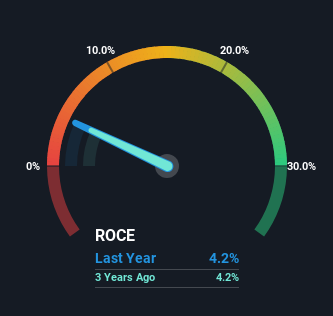- China
- /
- Metals and Mining
- /
- SHSE:600888
Xinjiang Joinworld's (SHSE:600888) Returns On Capital Not Reflecting Well On The Business
There are a few key trends to look for if we want to identify the next multi-bagger. One common approach is to try and find a company with returns on capital employed (ROCE) that are increasing, in conjunction with a growing amount of capital employed. Basically this means that a company has profitable initiatives that it can continue to reinvest in, which is a trait of a compounding machine. Having said that, from a first glance at Xinjiang Joinworld (SHSE:600888) we aren't jumping out of our chairs at how returns are trending, but let's have a deeper look.
Understanding Return On Capital Employed (ROCE)
If you haven't worked with ROCE before, it measures the 'return' (pre-tax profit) a company generates from capital employed in its business. To calculate this metric for Xinjiang Joinworld, this is the formula:
Return on Capital Employed = Earnings Before Interest and Tax (EBIT) ÷ (Total Assets - Current Liabilities)
0.042 = CN¥542m ÷ (CN¥17b - CN¥3.8b) (Based on the trailing twelve months to December 2023).
Therefore, Xinjiang Joinworld has an ROCE of 4.2%. In absolute terms, that's a low return and it also under-performs the Metals and Mining industry average of 6.6%.
See our latest analysis for Xinjiang Joinworld

Above you can see how the current ROCE for Xinjiang Joinworld compares to its prior returns on capital, but there's only so much you can tell from the past. If you'd like to see what analysts are forecasting going forward, you should check out our free analyst report for Xinjiang Joinworld .
How Are Returns Trending?
When we looked at the ROCE trend at Xinjiang Joinworld, we didn't gain much confidence. Over the last five years, returns on capital have decreased to 4.2% from 5.5% five years ago. Given the business is employing more capital while revenue has slipped, this is a bit concerning. If this were to continue, you might be looking at a company that is trying to reinvest for growth but is actually losing market share since sales haven't increased.
On a side note, Xinjiang Joinworld has done well to pay down its current liabilities to 23% of total assets. So we could link some of this to the decrease in ROCE. Effectively this means their suppliers or short-term creditors are funding less of the business, which reduces some elements of risk. Some would claim this reduces the business' efficiency at generating ROCE since it is now funding more of the operations with its own money.
In Conclusion...
From the above analysis, we find it rather worrisome that returns on capital and sales for Xinjiang Joinworld have fallen, meanwhile the business is employing more capital than it was five years ago. But investors must be expecting an improvement of sorts because over the last five yearsthe stock has delivered a respectable 71% return. In any case, the current underlying trends don't bode well for long term performance so unless they reverse, we'd start looking elsewhere.
If you want to continue researching Xinjiang Joinworld, you might be interested to know about the 1 warning sign that our analysis has discovered.
For those who like to invest in solid companies, check out this free list of companies with solid balance sheets and high returns on equity.
New: AI Stock Screener & Alerts
Our new AI Stock Screener scans the market every day to uncover opportunities.
• Dividend Powerhouses (3%+ Yield)
• Undervalued Small Caps with Insider Buying
• High growth Tech and AI Companies
Or build your own from over 50 metrics.
Have feedback on this article? Concerned about the content? Get in touch with us directly. Alternatively, email editorial-team (at) simplywallst.com.
This article by Simply Wall St is general in nature. We provide commentary based on historical data and analyst forecasts only using an unbiased methodology and our articles are not intended to be financial advice. It does not constitute a recommendation to buy or sell any stock, and does not take account of your objectives, or your financial situation. We aim to bring you long-term focused analysis driven by fundamental data. Note that our analysis may not factor in the latest price-sensitive company announcements or qualitative material. Simply Wall St has no position in any stocks mentioned.
About SHSE:600888
Xinjiang Joinworld
Engages in the research and development, production, and sale of aluminum products in China and internationally.
Excellent balance sheet second-rate dividend payer.
Market Insights
Community Narratives



